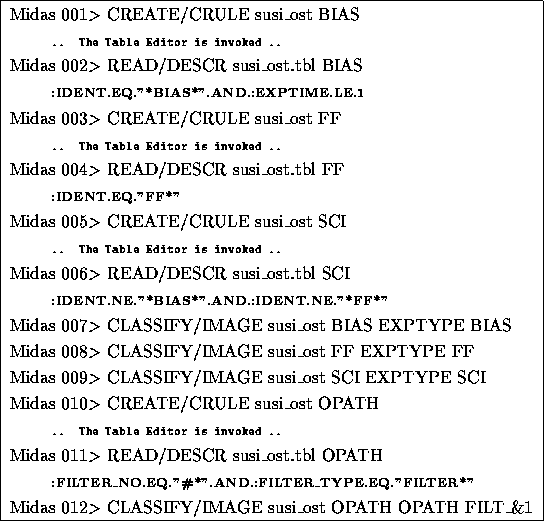



Next: An example of
Up: Classification of Images
Previous: Creation of the
The classification process (command CLASSIFY/IMAGE) tags each frame with
one or more character strings
supplied by the user that classify the image in a unique way and will be
stored into columns
of the OST. For instance scientific exposures observed
in SUSI using the filter number 639 may be described`
with the two strings ``SCI" and ``FILT_639".
The practical problem is however that the very large number of different
possible optical elements mounted on
instruments like
EMMI/SUSI is not fixed in advance; for example, filters may be
added or changed. Clearly, one do not want to write classification
rules for all filter numbers or all combinations of grisms and gratings.
We have for those reasons introduced the concept of `` Wild Card Replacement
Character";
This character & may be used to build the output classification string in
the following way:
substring& n will be built by finding the n-th occurrence of
the
 character in the classification rule, reading the content of the
corresponding column and appending it to substring.
character in the classification rule, reading the content of the
corresponding column and appending it to substring.

Table: MIDAS session for classifying SUSI exposures
Suppose you have created the classification rule WFIB for flagging all
exposures obtained in the blue arm of EMMI using the wide-field imaging mode.
Now you want to flag these exposures with a character string containing the
filter number that has been used.
The corresponding descriptor WFIB of the OST may in natural language be:
``frame exposed in the blue arm using any filter and no grating"
The translated selected criterion looks as follows:
:FILTB_ID.EQ."*".AND.:FILTB_TYP.EQ."FILTER*".AND.:GRATB_ID.EQ.""
The command
CLASSIFY/IMAGE ntt WFIB :OPATH FB&1
will flag all files in the OST ntt which satisfy this
selection criterion and will store in the column :OPATH the
character string obtained by appending
the contents of column :FILTB_ID to the string FB. The
classification given in the column :OPATH is obviously more convenient to use
than the original selection criteria.
Note:
This implementation of the sofware expects, for the association
process, that the type of the exposures is stored in a column labeled :EXPTYPE
and that frames classified as scientific exposures are flagged with the string
SCI.




Next: An example of
Up: Classification of Images
Previous: Creation of the
Rein Warmels
Mon Jan 22 15:08:15 MET 1996
 character in the classification rule, reading the content of the
corresponding column and appending it to substring.
character in the classification rule, reading the content of the
corresponding column and appending it to substring.
